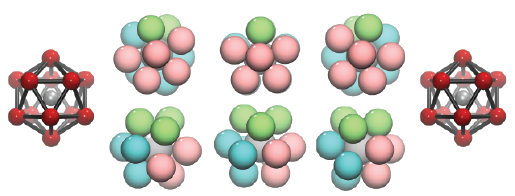N = 12 Transition Movie
The N=12 cluster is immobile significant range of diameter-to-diameter ratio. Thus, a large degree of rattling about the spherical code solution points can be observed. The N = 12 cluster has two rearrangements when it becomes mobile. The transition state of both actions requires being able to fit six spheres around a great circle of the central sphere, thus explaining why the two actions are activated at the same packing fraction. We corroborated this by observing a trajectory of an N = 12 cluster over 20 rearrangements. Ten of each action type were observed, supporting our observation that action type does not become activated at a lower packing fraction than the other.
The first rearrangement action involves rotating one ring of spheres relative to the cluster. In the movie, six spheres (a ring of five with a sphere cap colored pink) rotate counter-clockwise to other half of the cluster (also a ring of five with a sphere cap colored blue). One sphere in each ring is colored green so that the direction of the rotation is clear. The central sphere is colored silver. Not counting reflections (e.g. counter clockwise versus clock-wise rotations) there are six ways this action can occur.
The second N = 12 rearrangement also involves a rotation action but not of a ring. The N = 12 cluster can be divided into three groups of four spheres, each set in a rhomboid with a short and long axis. The three rhomboids twist clock-wise or counter-clockwise around an axis. The rearrangement twist the three rhomboids to the opposite chirality. In the movie, the sets of spheres in the three rhomboids are colored pink, blue, and green. A triangle of three spheres, one of each color, rotates counter-clockwise. If cluster was rotated so the back of the cluster was apparent, a triangle of three spheres would also be observed to rotate counter-clockwise. Not counting reflections, (e.g. counter clockwise versus clock-wise rotations), there are ten ways this action can occur. Like the other rearrangement of the N = 12 cluster, the transition state, or mid-point of this action requires six spheres to be able to fit around a great circle of the central sphere.
These movies are generated from a simulations, where the spheres are slightly soft. In the simulation Λ = 1.1, or more than the hard sphere ΛT=1.0
